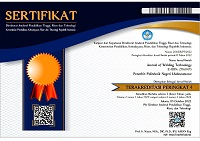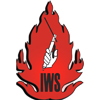Pengaruh arus pengelasan SMAW terhadap kekuatan sambungan las double lap joint pada material AISI 1050
Abstract
Pengelasan merupakan ikatan metalurgi pada sambungan logam atau logam paduan yang dilakukan dalam keadaan lumer atau cair. Mengelas adalah suatu aktifitas menyambung dua bagian logam atau lebih dengan cara memanaskan atau menekan atau gabungan dari keduanya sedemikian rupa sehingga menyatu seperti benda utuh. Kekuatan sambungan pengelasan merupakan syarat dari sebuah konstruksi terutama di industri migas seperti pada instalasi perpipaan dan tanki bertekanan. Prosedur mengelas dan parameternya merupakan suatu hal yang sangat mempengaruhi kekuatan dari sambungan las. Penelitian ini bertujuan untuk mengetahui kekuatan sambungan lap joint terhadap hasil pengelasan SMAW pada baja AISI 1050 dengan elektroda 7016.Variasi arus yang digunakan dalam proses pengelasan ini yaitu 100A, 125A dan 150A. Hasil penelitian menunjukkan bahwa arus pengelasan sangat mempengaruhi kekuatan sambungan las, hal ini dapat terlihat dari nilai kekuatan tegangan tarik dimana nilai tertinggi pada spesimen yang dilas dengan arus 100A sebesar 74.05 kgf/mm2, sedangkan untuk tegangan tarik terendah pada spesimen dengan arus pengelasan 150A dengan nilai tegangan tariknya sebesar 68.60 kgf/mm2. Hasil bentuk patahan setelah proses pengujian tensile test tidak terjadi pada daerah weld metal dan bentuk patahan yang terjadi dapat dikategorikan dalam bentuk patahan getas.
Abstract
Welding is a metallurgical bond in a metal or alloy metal connection which is done in a liquid state. Welding is an activity of joint two or more metal parts by heating or pressing or a combination of the two in such a way that they merge like whole objects. The strength of the welding joint is a prerequisite for a construction especially in the oil and gas industry such as in piping installations and pressurized tanks. The welding procedure and its parameters is a matter that greatly affects the strength of the welded joint. This study aims to determine the strength of the double lap joint to the SMAW welding results on AISI 1050 steel with 7016 electrodes. Current variations used in this welding process are 100A, 125A and 150A. The results showed that the welding current greatly affected the strength of the weld joint, this can be seen from the value of the tensile stress strength where the highest value in the specimens welded with a current of 100A was 74.05 kgf / mm2, while for the lowest tensile stress on the specimen with a welding current of 150A with a value of tensile stress of 68.60 kgf / mm2. The results of the fracture form after the tensile test does not occur in the weld metal area and the shape of the fracture that occurs can be categorized in the form of brittle fracture.
Keywords
Full Text:
PDF (Bahasa Indonesia)References
Syahrani, Awal Mustafa, and Oktavianus, “PENGARUH VARIASI ARUS PENGELASAN GTAW TERHADAP SIFAT MEKANIS PADA PIPA BAJA KARBON ASTM A 106 Abstract : The Influence of GTAW Welding Current Variation on Mechanical,” vol. 8, no. 1, pp. 721–729, 2017.
D. Jones, “Pengertian Las Listrik SMAW Shield Metal Arc Welding,” 2014. .
Wiryosumarto H., Teknologi Pengelasan Logam. Jakarta: Erlangga, 2000.
A. Hamid, “ANALISA PENGARUH ARUS PENGELASAN SMAW PADA MATERIAL BAJA KARBON RENDAH TERHADAP KEKUATAN MATERIAL HASIL SAMBUNGAN.,” J. Teknol. Elektro, Univ. Mercu Buan, vol. 7, no. 1, p. (ISSN:2086-9479), 2016.
W. Yu, M. Fan, J. Shi, F. Xue, X. Chen, and H. Liu, “A comparison between fracture toughness at different locations of SMAW and GTAW welded joints of primary coolant piping,” Eng. Fract. Mech., vol. 202, pp. 135–146, 2018.
D. Prayitno, H. D. Hutagalung, and D. P. B. Aji, “Pengaruh Kuat Arus Listrik Pengelasan Terhadap Kekerasan Lapisan Lasan pada Baja ASTM A316,” J. Din. Vokasional Tek. Mesin, vol. 3, no. 1, pp. 1–6, 2018.
S. A.Jalil, Z. Zulkifli, and T. Rahayu, “ANALISA KEKUATAN IMPAK PADA PENYAMBUNGAN PENGELASAN SMAW MATERIAL ASSAB 705 DENGAN VARIASI ARUS PENGELASAN,” J. POLIMESIN, vol. 15, no. 2, p. 58, Sep. 2017.
A. Azwinur, S. A. Jalil, and A. Husna, “PENGARUH VARIASI ARUS PENGELASAN TERHADAP SIFAT MEKANIK PADA PROSES PENGELASAN SMAW,” J. POLIMESIN, vol. 15, no. 2, p. 36, Sep. 2017.
V. A. Setyowati and S. Suheni, “VARIASI ARUS DAN SUDUT PENGELASAN PADA MATERIAL AUSTENITIC STAINLESS STEEL 304 TERHADAP KEKUATAN TARIK DAN STRUKTURMAKRO,” J. IPTEK, vol. 20, no. 2, p. 29, Dec. 2016.
A. Q. M Yogi Nasrul L., Heru Suryanto, “PENGARUH VARIASI ARUS LAS SMAW TERHADAP KEKERASAN DAN KEKUATAN TARIK SAMBUNGAN DISSIMILAR STAINLESS STEEL 304 DAN ST 37,” J. Tek. Mesin, vol. 24, no. 01, pp. 1–12, 2016.
A. Aditia, N. Nurdin, and A. S. Ismy, “Analisa kekuatan sambungan material AISI 1050 dengan ASTM A36 dengan variasi arus pada proses pengelasan SMAW,” J. Weld. Technol., vol. 1, no. 1, pp. 1–4, 2019.
J. Arifin, H. Purwanto, and I. Syafa’at, “Pengaruh Jenis Elektroda terhadap Sifat Mekanik Hasil Pengelasan SMAW Baja ASTM A36,” J. Ilm. MOMENTUM, vol. 13, no. 1, 2017.
T. Endramawan, E. Haris, F. Dionisius, and Y. Prinka, “Aplikasi Non Destructive Test Penetrant Testing (Ndt-Pt) Untuk Analisis Hasil Pengelasan Smaw 3g Butt Joint,” JTT (Jurnal Teknol. Ter., vol. 3, no. 2, pp. 44–48, 2017.
ASME Code Section V Article 6. New york: ASME, 2013.
ASME E8/E8M, Standart Test Methods for Tension Testing of Metallic Material. West Conshohocken, United States: American Society for Testing Methods.
DOI: http://dx.doi.org/10.30811/jowt.v2i1.1833
Refbacks
- There are currently no refbacks.

This work is licensed under a Creative Commons Attribution-ShareAlike 4.0 International License.
Ciptaan disebarluaskan di bawah Lisensi Creative Commons Atribusi-BerbagiSerupa 4.0 Internasional.
Mailing Address:
Politeknik Negeri Lhokseumawe
Jl. Banda Aceh-Medan
Km. 280,3, Buketrata, Mesjid Punteut, Blang Mangat,
Kota Lhokseumawe, 24301
Propinsi Aceh,
Indonesia























